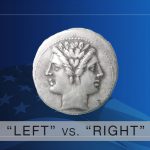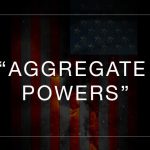Last Updated on October 3, 2021 by Constitutional Militia
“[S]windling”, however, is not the product of the unconscious forces of Nature. It cannot occur without human action—that is, without purposeful behavior by identifiable individuals. So the critical questions become, “With respect to America’s National debt, who is ‘swindling futurity on a large scale’?” and “Why are they not being punished in proportion to their crimes?”
In its origin and structurally, public debt is not the same as private debt. Although formal “lenders” and “borrowers” are to be found in both cases, where public debt is concerned the actual borrowers are never also the primary payors. Although the people’s purported “representatives” arrange the loans, they pledge their constituents’ assets as collateral. Here lies the fatal defect in the Hamiltonian “funding” system: Because the individuals who borrow are different individuals from those who will ultimately be forced to pay, the interests of the borrowers, as well as of the lenders, can (and usually do) become so disconnected from the interests of the payors that the borrowers collude with the lenders at the expense of the payors.
At that point, the “funding” system becomes an exceedingly dangerous combination amongst rogue public officials and financial speculators against the general public, for at least two reasons:
• First, it is a combination especially easy to contrive and manage. On the one hand, the “representatives” can be cöopted or captured by the lenders and the well organized and funded special-interest groups allied with them. On the other hand, many among the affected population can exert no countervailing political influence—indeed, can have no way of knowing, let alone doing anything, about what is being imposed upon them—because they are either in their minorities or not even in existence at all when are incurred the debts for the repayment of which they will eventually be held liable.
• Second, it is a combination especially prone and likely to get out of hand, because of the synergistic interaction among human avarice, ambition, and the appetite for abusive powers.
On the one hand, the lenders are intent upon securing for themselves a stream of income guaranteed by “the full faith and credit” of the government—which means, in actuality, the government’s ability and willingness to apply unlimited force to the people in order to extract from them the wherewithal to pay the debt. For that reason, the lenders will promote expansion of the government’s power to tax and otherwise loot the citizenry. As a practical matter, the lenders “invest” in the metastasis of the apparatus of governmental coercion. In addition, the lenders “invest” in the metastasis of governmental powers across the board, so as to create new excuses for the government to spend and therefore to borrow.[4] Thus, on the side of the lenders, the Hamiltonian “funding” system is a formula for ever-expanding statism.
So, too, on the side of the public officials who incur the debts. Rogue officials favor ever-increasing public debt as a means to increase governmental spending, which rationalizes ever-increasing governmental power. The larger and more powerful the government, the more secure their political careers, and the greater the authority, personal prestige, and financial benefits that accrue to them.
Worse yet, in the process of incurring public debt, the lenders often effectively sit on both sides of the bargaining table. Of course, on one side, the lenders represent themselves. But, on the other side, the public officials represent the lenders, too, because the lenders either secure the election of those officials through campaign-contributions or capture them later on through lobbying and other forms of behind-the-scenes influence. No one at the table stands up for Mr. and Mrs. America and their children, who will be made to foot the bill.
Finally, because the borrower is always the servant of the lender, once the public debt has grown sufficiently large that public finance has degenerated effectively into a Ponzi scheme, the lenders hold even honest public officials hostage. Just as with the dope-fiend who is always dependent upon his next fix, public officials must enter into more and ever more loans—constantly raising “the debt ceiling” of their addiction—or the government will collapse in financial ruin. So, just as with the dope-fiend who steals from his family and friends in order to support his habit and to avoid having to “go cold turkey”, public officials will impose any financial burden on the masses in order to salvage their own careers.
It is no answer to these objections to posit the possibility that a significant proportion of the general public may, directly or indirectly, hold some large part of the public debt.[5] First, as this proportion of the public always exists in the present, not the future, its mere size does not obviate—but in fact on that score may exacerbate—the intergenerational conflict inherent in public debt. Second, no reason exists why a significant proportion of the public —even comprising a majority—cannot constitute a “faction” inimical to the common good.[6]
Today in America, this process has progressed to the point at which the interests of the borrowers and the lenders have become, not simply adverse, but even aggressively antagonistic, to the interests of the payors. The speculators in New York City and their political puppets in Washington, D.C., are arrayed against the vast mass of Americans, both present and future, in a conflict that is not amenable to compromise.
The question is, “Can common Americans prevail?”
It has become somewhat trite to point out that the Chinese ideograph for “crisis” includes the ideas “danger” and “opportunity”. But that observation still has merit.
At this juncture, the “opportunity” is for Americans to realize that Hamilton’s system has not worked, and can never be made to work, and therefore must be replaced—immediately, if not sooner. The present situation provides Americans with the best chance they have ever had to kill two vultures with one stone: first, the link between excessive governmental debt and excessive governmental power; second, debt-currency, fractional-reserve central banking, and the integration of bank and state, without which the present gigantic Ponzi-pyramid of supposed public debt could never have been erected.
The “danger” is that while Americans are mulling over what do to about this situation, the rogue politicians and crowd of bankers and financial speculators that pull their strings will betray this country once again—and in their expectation finally and decisively—by
(i) “stabilizing” the tottering Federal Reserve System through the banking cartel’s integration into a supra- national central bank capable of emitting a supra- national currency,[7] closely followed by
(ii) “stabilizing” America’s National debt with loans made and payable in the new currency—complete, of course, with severe “conditionalities” that will set in stone the pyramid of perpetual public debt with the cement of the people’s permanent penury.[8]
I describe this as a “decisive” betrayal, because the Forces of Darkness expect that, once a supra-national central bank and fiat currency have been set into operation, and this country’s crushing load of National debt has been tied to that new régime, Americans will be unable to do anything—economically, politically, or legally—about it for generations, if ever. For the borrower is servant to the lender; and if the debt can never be paid off, the servitude can never be ended. After all, what have Americans been able to do about the depredations of the Federal Reserve System in the nearly one hundred years since its illegitimate birth in 1913? From the collapse of the economy in 1932 and the seizure of the people’s gold in 1933-1934, to the palpably criminal “bail outs” and “quantitative easings” of the present day, no crime has been too outrageous for the banking and financial racketeers to commit—yet next to nothing has been done about any of them. So, if a domestic central bank has proven to be largely immune from popular control, how much more immune will a supra-national central bank be?
Moreover, this immunity will have the most serious of consequences. For, just as the erection of the Federal Reserve System effectively transferred supreme domestic governmental power to bankers and financial speculators, so that Congress has become shamelessly subservient to them, so will the establishment of a supra-national central bank effectively transfer America’s very national sovereignty to that cabal, so that Congress will become, not merely impotent, but completely irrelevant to the scheme of financial control that will be fastened on the American people. This is a scheme, not simply for violating the Constitution of the United States, but beyond that for overthrowing the Declaration of Independence.
So, the main thing is to recognize that, at base, America is confronted, not with a merely economic problem, but with a profoundly political and legal problem. If the latter is not solved in time, the former will eventuate in catastrophe.
Politically, Americans must decide once and for all who is in control of the government of the United States—WE THE PEOPLE, or the bankers, the financial speculators allied with them, and their lap-dog political front-men. And once the proper order of precedence has been established, Americans must determine to use the Constitution and laws
[1] to separate the Treasury from financial speculators to the greatest degree possible, and
[2] to separate bank from state finally and absolutely.
As I have already dealt with the second of these in my address “Cross of Gold”, presented to this assembly at its October meeting in 2010 (and available in full on NewsWithViews), I shall focus only on the first of these goals.
How might Americans go about separating the Treasury from financial speculation to the greatest degree possible?
I believe that the best way to proceed is for WE THE PEOPLE to act through their States, as economic, political, and especially legal vehicles for “change we can believe in”.
A. The first step in this corrective process must be to prevent the present problem from becoming any more serious, by imposing strict limitations on public indebtedness in the future.
To saddle future generations of Americans with a staggering load of public debt is more than just financially imprudent or even morally problematic. At some point, it becomes positively illegal. The only time the Constitution expressly addresses the concerns of the future is when it declares WE THE PEOPLE’S intent “to * * * secure the Blessings of Liberty to ourselves and our Posterity”.[9] Now, generally, a servant is subject to the control of his master. Therefore, relative to his master, the servant is deprived of liberty. Specifically, “the borrower is servant to the lender”—his servitude proportional to the degree of his indebtedness. So, if “our Posterity” are cast in the rôle of involuntary “borrowers” of sums so huge that repayment is impossible, they are thereby consigned to the permanent status of “servants”—and worse than even indentured servants, because they never agreed to their servitude— and in that thralldom are not “secure[d]” in “the Blessings of Liberty”, but instead are stripped of them.
This is contrary to the explicit purpose of the Constitution “to * * * establish Justice” as a permanent condition.[10] For “our Posterity” will have had no notice of, will have been afforded no hearing as to, will have taken no other part in, and certainly will never have given their permission for, the transactions that incurred the supposed public debt for the repayment of which they will be taxed or otherwise mulct. It will have been physically impossible for those of “our Posterity” who were not even alive at the time to be observers of, let alone parties to, these transactions. Therefore, imposing a liability upon them to pay off these debts—ultimately to be enforced through taxation imposed at the point of bayonets—amounts to the quintessential case of “taxation without representation”.
It is bootless to contend that “our Posterity” will have been “virtually represented” by the past and present generations of Americans. Historically, this apology is lame. America’s Founders were “virtually represented” by members of Parliament who were actually their contemporaries—and nonetheless they rejected such “representation” as insufficient, if not fraudulent. Indeed, “imposing Taxes on us without our Consent” in the present was one of the “Facts submitted to a candid world” which the Declaration of Independent set out as evidence that “[t]he history of the present King of Great Britain is a history of repeated injuries and usurpations, all having in direct object the establishment of an absolute Tyranny”. One wonders how “imposing Debts on us without our Consent”, on an intergenerational basis, could sound any less in usurpation and tyranny. For part three click below.



































